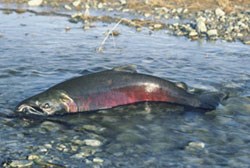
Coho Salmon - Oncorynchus kisutch Identification: 
Spawning: Coho are sometimes differentiated into the summer-run and fall-run stocks. Throughout summer, but primarily in late September and early October, these coho from the Pacific enter the Sol Duc River by means of the Quillayute River and leap, with great determination, over the cascades en route to their spawning grounds. The taxing journey of over 50 miles leaves the salmon scarred and deteriorated. From the time they emerge from the gravel, young coho spend about one year in their natal steams before venturing to sea as a smolt. Generally, they will spend about two years in sea growing to proper size before heading back to the rivers to spawn. Good viewing locations include the Salmon Cascades in the Sol Duc River in October, and the small tributary of the Hoh River, accessed by the Hoh Visitor Center nature trail in November and December. Conservation Status: Only 4.9 miles of the Elwha are currently available to returning coho. Between 5,000 and 18,000, of coho return each year to the Elwha River, a majority of which are reared in the tribal hatchery. (Historical Range Map) After removal of the dams, wild stocks will be reintroduced and coho returns should reach numbers of up to 16,000 spawners after about 15 years.
|
Last updated: April 24, 2025

